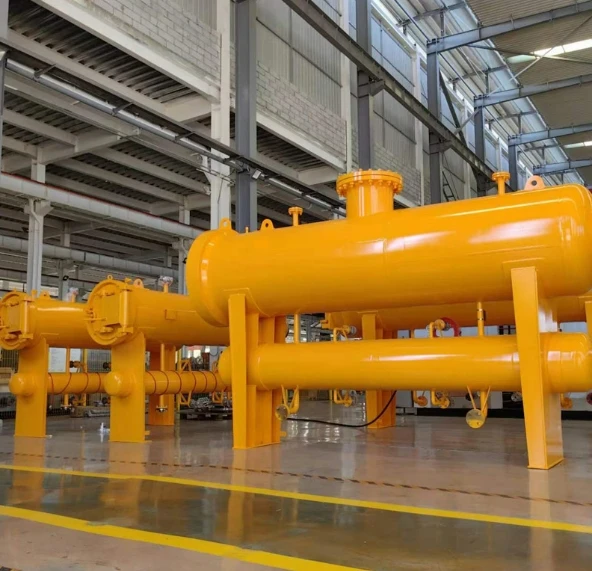
Oct . 09, 2024 23:39
Back to list
filter separator
Understanding Filter Separators Key Components in Fluid Separation
In the realm of industrial processing and oil and gas applications, the efficiency and effectiveness of separating different phases of fluids—such as water, gas, and oil—are crucial to ensuring optimal performance. One of the integral devices designed for this purpose is the filter separator. Understanding how filter separators function and their significance in various industries is essential for those involved in engineering, environmental management, and operational processes.
What is a Filter Separator?
A filter separator is a device that combines the processes of filtration and separation to remove impurities from a fluid stream. Its primary function is to separate solid particles and liquid droplets from a gas or liquid phase. This is particularly significant in applications where clean fuel or product quality is mandatory, such as in natural gas processing, petrochemical industries, and water treatment facilities.
These devices typically consist of three key components a filtering element, a vessel for phase separation, and an outlet for the separated components. In essence, a filter separator works by first filtering out larger solids and then separating the lighter phase (gas) from the heavier phase (liquid).
The Operating Principle
The operation of a filter separator can be broken down into various stages. Initially, the incoming fluid enters the vessel, where it is directed towards the filter element. This element, often composed of porous materials, captures large particulates and other solid contaminants. As the fluid passes through the filter, smaller solids may still be carried along, which is why the following separation process is critical.
Once the filtering process is complete, the fluid moves into the separation region. This part of the separator uses principles of density difference to promote phase separation. The heavier liquid droplets, such as water or oil, settle to the bottom of the vessel due to gravity, while the lighter gas phase rises to the top. In some designs, coalescing filters are utilized to enhance the separation process by encouraging smaller droplets to combine into larger ones, thus facilitating their removal.
filter separator

After sufficient time has elapsed for effective separation, the clean gas can be directed to the outlet for further processing or use, while the separated liquids are collected for disposal or further treatment. This streamlined process ensures that the output meets the necessary quality standards for industrial applications.
Benefits of Using Filter Separators
The advantages of employing filter separators are manifold. Firstly, they improve the quality of the output fluid, which is vital in industries where contamination can lead to severe operational issues. For instance, in gas processing, removing water vapor and particulate matter helps to prevent corrosion in pipelines and ensures the safe transportation of gas.
Additionally, filter separators contribute to operational efficiency. By effectively removing impurities, they reduce the risk of equipment wear and tear, leading to lower maintenance costs and prolonged equipment life. Moreover, cleaner outputs often lead to better compliance with environmental regulations, minimizing the risk of costly fines and environmental damage.
Further, filter separators are designed for versatility and can be customized to handle different types of fluids and contaminants, making them suitable for a range of industries—from cosmetics to pharmaceuticals, and from food processing to wastewater treatment.
Challenges and Considerations
While filter separators offer numerous benefits, operators must also consider potential challenges. Regular maintenance is required to ensure that filtration systems do not become clogged, which can impede fluid flow and reduce efficiency. Additionally, the selection of the appropriate filtering material and separator design is critical to optimal performance, necessitating expertise in fluid dynamics and material science.
In conclusion, filter separators play a vital role in modern industrial applications by enhancing the quality and efficiency of fluid processing. As industries continue to evolve and place greater emphasis on sustainability and efficiency, the importance of effective filtration and separation solutions will only increase. Understanding the workings and benefits of these devices will allow professionals to leverage their capabilities, ensuring successful operational outcomes in a variety of settings.
Latest news
-
Safety Valve Spring-Loaded Design Overpressure ProtectionNewsJul.25,2025
-
Precision Voltage Regulator AC5 Accuracy Grade PerformanceNewsJul.25,2025
-
Natural Gas Pressure Regulating Skid Industrial Pipeline ApplicationsNewsJul.25,2025
-
Natural Gas Filter Stainless Steel Mesh Element DesignNewsJul.25,2025
-
Gas Pressure Regulator Valve Direct-Acting Spring-Loaded DesignNewsJul.25,2025
-
Decompression Equipment Multi-Stage Heat Exchange System DesignNewsJul.25,2025

